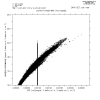george_victor
New member
Hi!
I was making an LES simulation over ocean and seaice grids. While analyzing the outputs, I found that the sea surface roughness length (ZNT) is in correlation with the wind speed (checked for various heights up to 50m from the surface). Although the correlation is not precisely 1, I was confused to see a positive correlation.
I'm confused because I thought these parameters should be having a negative correlation. I've attached a scatter plot with the wind on the y-axis and znt on the x-axis for your reference.
I went through the model codes but is not clear to me, how exactly znt is estimated. If ZNT is estimated based on the windspeeds, the result would make sense, higher windspeeds contributed to rougher ocean surface and hence higher ZNt. However, if it is otherwise, then I don't understand it.
My parameterization: sf_sfclay_physics= ETA similarity scheme (2) and sf_surface_physics= Noah LSM (4).
By the way, please note that in my case, windspeeds are mostly above 10m/s. Additionally, I'd like to mention that other model outputs seem OK.
Can someone tell me, if ZNT is estimated based on the windspeed, or is it the other way around?
Thank you in advance.
I was making an LES simulation over ocean and seaice grids. While analyzing the outputs, I found that the sea surface roughness length (ZNT) is in correlation with the wind speed (checked for various heights up to 50m from the surface). Although the correlation is not precisely 1, I was confused to see a positive correlation.
I'm confused because I thought these parameters should be having a negative correlation. I've attached a scatter plot with the wind on the y-axis and znt on the x-axis for your reference.
I went through the model codes but is not clear to me, how exactly znt is estimated. If ZNT is estimated based on the windspeeds, the result would make sense, higher windspeeds contributed to rougher ocean surface and hence higher ZNt. However, if it is otherwise, then I don't understand it.
My parameterization: sf_sfclay_physics= ETA similarity scheme (2) and sf_surface_physics= Noah LSM (4).
By the way, please note that in my case, windspeeds are mostly above 10m/s. Additionally, I'd like to mention that other model outputs seem OK.
Can someone tell me, if ZNT is estimated based on the windspeed, or is it the other way around?
Thank you in advance.

